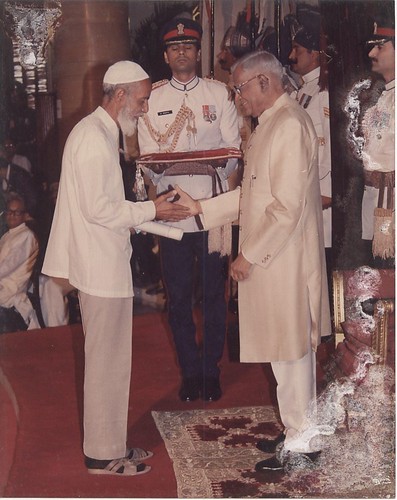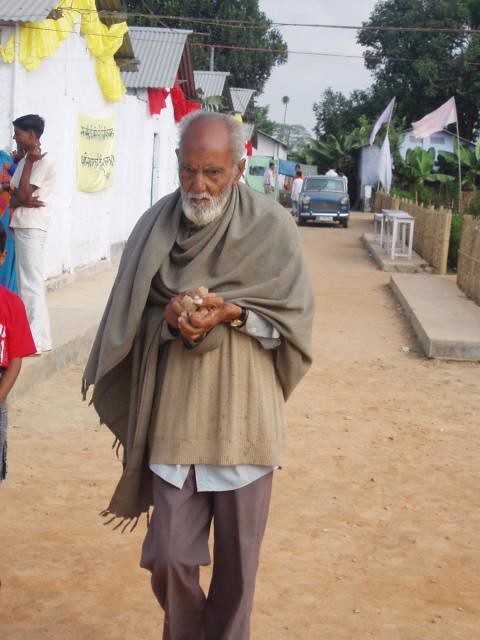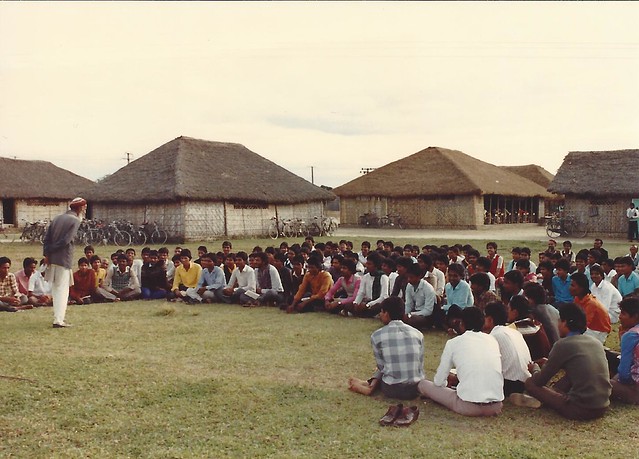By Saba Syed Hafeez for TwoCircles.net,
Leaving behind a charming life and promising future in America, a humble servant of mankind arrived in the soils of India to Kishanganj exactly 51 years ago in January 1965. He worked tirelessly with the flag of humanity in one hand and the masha’al (torch) of enlightenment in the other hand, touching millions, perhaps indirectly billions, of lives and changing everything around them. Now this khak e zameen (piece of earth) took him in her aaghosh (arms), comforting him in his eternal sleep.

Affectionately known as Syed Bhai, the founder of INSAN, Dr. Syed Hasan, left us all in the early hours of Monday, January 25, 2016, for a heavenly abode. Inna lillahi wa inna ilayhi raji’oon (To God we belong and to Him we return).
A few years ago, INSAN alumni were compiling their encounters with Dr. Hasan as “What I learned from Syed Bhai”. I am sharing here, perhaps one of my earliest lessons of humanity by my father when I was 7 years old. It was a profound experience which he planted in me.

When we first settled in Kishanganj, people invited us often to their homes just to join them for a snack or for a meal. One afternoon my father was invited and asked me to come along. Naturally, I thought that it would be with one of elite family. When we arrived at the destination it was a different story. We had come to one of our laborers who used to do most of the painting tasks, especially fences, gates, etc. He was a Bengali Da (fellow). He had a very small and humble hut. I think he was in his 50’s or he might have looked aged due to hardships in his life. His wife prepared some cholay (a snack made of garbanzo beans) and tea for us, then served it neatly as Bengalis, even poor, are famous for their tidiness. The entire time they were gleaming with joy. When we were departing, they thanked us and gave us duayen (blessings) and I saw them crying. Tears were running from their eyes and I could not understand why or what was happening but remained quiet. My father realized this and on our way back he explained:
Ek ghareeb ka dil rakh kar, usey izzat de kar, aap ne use kitni khusi dee (by extending your love and respect to a poor, you gave him great happiness).
Once in a while, perhaps in a century, God blesses humanity with person like Dr. Hasan, who lived such an extraordinary and unparalleled life. If we happen to witness, we are part of the history; if we are touched, it is a profound impact we experience. Dr. Hasan was such a person.
He was born on September 30, 1924 in the small town of Jehanabad in Bihar. His mother named him “Syed” after her mentor, 19th century reformer Sir Syed Ahmed Khan. She personally wanted to study at Aligarh Muslim University but wasn’t allowed. This incident turned her son into a forceful advocate for women’s education later. When he was 10 years old, on his mother’s insistence, the family enrolled him in a school all the way in Delhi at Jamia Millia Islamia.

From here he started an incredible journey of life. He groomed himself at Jamia and later in America for much higher tasks; having teachers like Dr. Zakir Hussain, who later became the 3rd President of India, spending time with Allama Iqbal and Mahatma Gandhi, sheltering of 200,000 refugees during the pre-independent sectarian violence in Delhi. Afterwards, in his 10 years of stay in America, he experienced the leading economical, educational, and scientific developments and social reforms.
In his 5th grade book he read about the Japanese youths who went abroad for study. They returned home and served in the building of their nation, which kindled his young heart. At the age of 13, after meeting with poet Allama Iqbal, he made a firm decision to serve others and by 18 he had clearly chosen education as a medium to his commitment.
Growing up in India and later in America, he sadly observed a shattered, burning, inhumane world all around him; injustice of colonial British Raj in India, World War ll, The Holocaust, and disparity of human lives, both in India and the U.S, in the name of segregation. However, he also saw rays of hope and was inspired by the non-violent independence movement, peace effort, nation building and other progressive initiatives in India and abroad. He realized that it is human inability to live together in harmony that causes all the miseries, and only through education can we develop a society we would all desire.

After returning from the U.S. he literally headed to the jungles and then to a small town called Kishanganj at the tri-junction of India, Bangladesh and Nepal. With this, the service phase of his journey began! That was 51 years ago, when there were only three colleges in the whole region. Similarly, the number of schools could be counted on the fingers. Today there are more than 50 colleges and 1000s of schools in this region.
For the first two years, he had to do some ground work; campaigning for educational awareness and social uplifting as well as teaching kids and youths in the various settings including madrassas and at homes. He assisted in the foundation of a college and a high school. People were often amazed to see someone in western clothes digging dirt and cutting bamboo for classrooms, or touring tens of miles on feet and walking in mud knee deep just to meet the locals. Many thought he was a spy or perhaps he was total nuts.
He was passionate about his mission and invited others to join him. “Aou aur is divangee mein shareek ho kar iska lutf uthao (Please come and enjoy by participating in this ferver)”, he wrote to his first team member. A poet penned what he was witnessing in the following verses:
Nigah e shoq ne dhondhi hai koi manzil e nau
Muhabbat aur murawwat mein aftaab ki lau
Chand ahle janoon ke janoon ka hai par tau
Na thakne wale qadam ka karishma aye tak dau
Kahein se shahad liya and kahein se itr liya
Phir is qeemti shai ko jehaan mein baan’t diya.
Zealous eyes have found a new destiny
Flame of sun in love and compassion
Relentless intensity of passionate ones
Miracle of untiring legs
Honey and essence from different places
Shared these invaluable gifts to the world
He wanted to spread education and worked tirelessly to do so. He saw “Education [as] light to remove the darkness of the society”. His flagship, INSAN School, became a model and inspiration to many and attracted students from as far as Kolkata and Delhi. But education was much more to him than just obtaining a degree.
“The most valuable resource any society has is Insan – humans themselves; education plays a vital role in developing these precious assets”
He further believed:
“Education is a key in solving some of the challenges we face whether locally or globally”
As the name INSAN, meaning human, reflects, his mission had always been for insaaniyat (humanity).

Therefore, he turned INSAN into not only a unique educational and social lab, but a platform for humanity. Most people thought of INSAN as a school, or college at best, so they always questioned and were puzzled by an academic institution having such programs like adult literacy, mental health, criminal reform, caring and assisting disadvantaged along with others.
Insaan bane ge hum insan banayen ge
Jeene ke tareeque ab seekhen aur sikhaein ge
Pledging to become and teaching to be humans
Learning, embracing, and teaching ways to live in harmony
So the very first lesson his founding students learned was metaphorically taught. They sang the following song while plucking weeds from the playground at INSAN’s inception on November 14, 1966:
Chun chun kaante door hatao
Prem ke pag pag phool khilao
Dharti ko gulzar banao
Find and remove the thorns (suffering and infliction)
Blossom the flowers of love all around (for everyone)
Let’s make the earth a beautiful garden (of peace and harmony)
He aspired to spread education, reform education, and use education as a tool for humanity. And indeed what a great job he did!
From cleaning toilets to eating with mehters (toilet cleaners) and mazdoors (laborers), he was a down to earth reformer, always a humble servant to humanity. He kept himself away from the limelight and never took a penny for himself from INSAN or any organization or project. Dr. Hasan was a living example of “simple living and high thinking”; he lived a life of extreme modesty. People were taken a back at first, but later admired him. As one reporter described:
“…The most overwhelming experience I encountered was when I was searching for Dr. Hasan. Looking for him, I asked the whereabouts of Dr. Hasan from a laborer doing something on the dirt with knees down. The person, after wiping his hand on the grass, got up, and extended his hand with smile and said people call me Syed Hasan”
He had a deep sense of empathy where he would clean the blood and urine of TB patients, help the mentally challenged and those in need. He employed often more mazdoors (laborers) than needed as he believed of giving them a platform of earning honorably rather than only empty slogans, “…what options would they have otherwise; starve, beg, or steal?”
Jis me na koi hoga nanga na koi bhooka
Ab nai basti hum ayesi basayen ge
None will be hungry or unclothed
Let’s strive now to create such a world
He loved people, particularly students, and students loved him. When he was leaving Jamia for America, everyone was crying; much the same, today all are crying once again. When the student body voted him for the “Teacher of the Year Award”, he told his students in the U.S. “To me as a teacher, this honor means more than earning a Ph.D.”
They also found him to be like a messiah. Often in the evenings, there were people standing in line, mostly poor, who just wanted him to give them some dua’a (prayers). One time, he heard the news of someone’s illness in a tense time of his life during which he received many threats. Against everyone’s advice he asked to rent a rickshaw. As they were passing through empty streets, the rickshaw puller realized Syed Hasan’s situation and, as there was still a large number of people who would protect him over their own lives, said, “Syed Bhai do not worry, hundreds of people of my community will run out when I will call”.
Always committed to his causes with unwavering determination, he would never stop regardless of challenges or obstacles. For example, in 1983 one of the campuses was burnt down. The next day, some of the well wishers and parents came to visit. They were astonished to see that all the classes and the routine work were going on with calm and normalcy. He had told his students and staff, “Kaam rakhon par hoga (the work will continue on ashes)”.
He was a deeply spiritual person, a practicing devout Muslim. His actions and mission have always reflected his deep rooted religious beliefs, and peaceful teachings of all religions. He believed in the goodness of people. When he was in Jamia he was moved to know that when the lives of his own family and other relatives were threatened during the riots, it were the Hindu co-villagers who had formed a wall to save his loved ones from the wrath of their own.
Furthermore, his work was not limited to his own organization or the region. He had also helped in many organizations and projects at both, state and national levels. In addition, he benefited over a billion people throughout the last 40 years because of some of his policies that were adopted by the Government of India.
Locally, from the Kishanganj area to Rajasthan, from Qatar to the US, there are many who are furthering his message of humanity in different parts of the world and working on causes such as education, human trafficking, and homelessness.
As an adamant proponent of human brotherhood and dignity, mutual understanding and tolerance, peaceful coexistence and religious harmony, his Shiksha Nagar, as cited by a national magazine, became “a place to develop humans”, where all can study, work, and live together. He taught the world that everyone is Bhai (brother) or Bajie (sister) whether teacher, student, administrator or street sweeper, regardless of race or religion.
Kuch zaat ho kuch mazhab kuch taur tareeqe hon
Mil jul kar magar rahna hum sub ko sikhaeyen ge
Despite the differences of cast, culture or religion
To reach across and to teach how to live with amity
And what a beautiful lesson he gave us. During his burial service, in the midst of the ocean of people, everyone was anxious to give a shoulder to carry his body towards his final destination, regardless of their religion.
All this happened due to one teen aged boy who made a firm commitment to serve fellow insan (humans). What a phenomenal journey!
As an educator, he was an open book to be learned. As a humanitarian, he was a walking inspiration to be followed.
(Saba Syed Hafeez is the Son of Syed Bhai)

